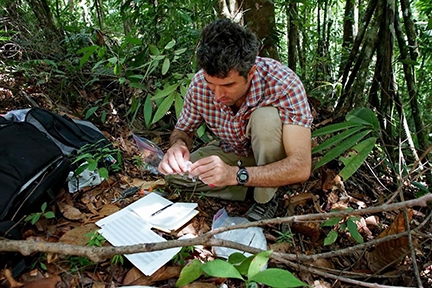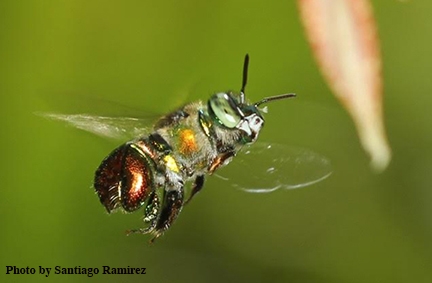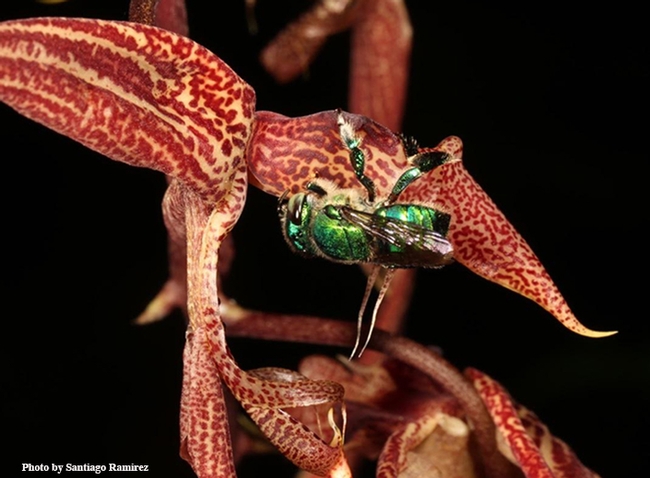
Heaven scent?
Orchid bee researcher Santiago Ramirez, an assistant professor in the UC Davis Department of Evolution and Ecology, will discuss his work on Sunday, May 7 at the third annual UC Davis Bee Symposium in the UC Davis Conference Center on Alumni Drive. He'll speak at 10:45 a.m. on “The Evolution and Chemical Ecology of Orchid Bees.”
The all-day symposium, sponsored by the UC Davis Honey and Pollination Center and the UC Davis Department of Entomology and Nematology, begins at 9 a.m. with registration and a continental breakfast. Amina Harris, director of the Honey and Pollination Center, and Neal Williams, assistant professor, UC Davis Department of Entomology and Nematology, will welcome the crowd. Registration for the event continues today through Wednesday, May 3.
Orchid bees, distributed throughout South and Central America, are easily distinguished by their brilliant metallic coloration, primarily green, gold and blue.
“Insects rely more on chemical signals than on any other sensory modality to find, identify, and choose mates,” Ramirez points out. “Euglossine--or orchid--bees constitute a diverse group of conspicuous insect pollinators from tropical America. Male euglossine bees do not produce their own pheromones, but instead gather and accumulate perfume compounds from orchid flowers, fungi, and other resources, to subsequently present to females during courtship display.”

The intellectual merit? “Most insects rely on chemical signals (semiochemicals) to gain precise information on the location, identity, and quality of potential mates," Ramirez says. “Despite the ubiquity and importance of semiochemicals across the insect phylogeny, the underlying genetic and molecular mechanisms that control signal chemistry and signal detection remain poorly understood. Moreover, whether insect sex semiochemicals mediate reproductive isolation, speciation, and lineage diversification remains surprisingly unexplored given the vast diversity and ecological dominance of insects on Earth.”
His project involves integrating diverse techniques from multiple disciplines, including behavioral ecology, chemical ecology, population genetics, functional genomics, and neuroethology “to answer specific questions about the genetic basis, function, and evolution of chemosensory communication in arguably one of the most important groups of insect pollinators in the American tropics.”
“This project offers unique training and educational opportunities,” he says. “One postdoctoral researcher, one graduate student, and several undergraduate assistants will receive training in entomology, chemical ecology, population genetics, molecular biology, and neuroethology.”
Ramirez expects the field and laboratory work in South and Central America to “foster greater international cooperation, broadening our impact in the education and training of future scientists from diverse backgrounds. We have a track record of collaborating intimately with museums, public exhibits, filmmakers, botanical gardens, and educational institutions to disseminate our work on euglossine bees and their intricate associations with orchids.”
“They are extremely charismatic organisms and we are currently planning to join forces with a botanical garden to install an interactive exhibit on euglossine bees," he says. "Our research will contribute toward the wider goal of gaining a better understanding of the natural world, including key organisms such as insect pollinators. The results derived from this investigation are likely to be of interest to the general public.”
Ramirez received his bachelor's degree in biology, with honors, from the Universidad de los Andes (Colombia) in 2001, and his doctorate in organismic and evolutionary biology from Harvard University in 2008. He served as a postdoctoral fellow at UC Berkeley from 2008 to 2012 before joining the UC Davis faculty in 2013.
Keynote speaker at the event is Steve Sheppard, Thurber Professor of Apiculture and chair of the Department of Entomology, Washington State University (WSU), Pullman, Wash. His topic is "Bees, Mushrooms and Liquid Nitrogen--What?" Sheppard's research involves improving honey bee health through breeding and alternative treatment approaches. He specializes in population genetics and evolution of honey bees, insect introductions and mechanisms of genetic differentiation.
Among the other speakers:
- Extension apiculturist Elina Niño of the UC Davis Department of Entomology and Nematology will introduce the apprentice-level California Master Beekeepers and present them with pins
- Researcher Maj Rundlöf, International Career Grant Fellow, UC Davis Department of Entomology and Nematology, will discuss “Flowering Crops: A Tricky Treat for Bees”
- Veterinarian Michael Karle of the Mid-Valley Veterinary Hospital, Oakland, will speak on "The New FDA Rule on the Use of Antibiotics in Hives"
- Margaret Lombard, chief executive officer of the National Honey Board, to discuss "Good as Gold: Growing Opportunities for the Small-Scale Honey Producer."
Also included will be a "Lightning Round," with each presentation spanning four to six minutes.
The topics:
- "Bumble Bee Cognition in the Wild" by Felicity Muth, postdoctoral researcher, Department of Biology, University of Nevada, Reno
- "Habitat Planting for Bees," by the Neal Williams' lab, UC Davis Department of Entomology and Nematology
- "Optical Tagging of Bees to Track Individual Movements in colonies" by Stacey Combes, assistant professor, UC Davis Department of Neurobiology, Physiology and Behavior
- "Planet Bee: Citizen Bee Projects" by Debra Tomaszewski, executive director and co-founder of the Bay Area's Planet Bee Foundation
- "Plants and Pesticides: Keeping Bees Healthy with Ornamental Horticulture" by Christine Casey, program representative, Häagen-Dazs Honey Bee Haven, UC Davis
Graduate students throughout California will be showcasing their pollinator-related research in the Graduate Student Poster Competition, a traditional part of the symposium. The winners will be announced at 4:15, at the conclusion of the symposium. Awards are first place, $1000; second place, $750; third, $500; and fourth, $250.
To register for the symposium, access http://honey.ucdavis.edu/events/2017-bee-symposium. Amina Harris can be reached at aharris@ucdavis.edu for further information.
Attached Images:

